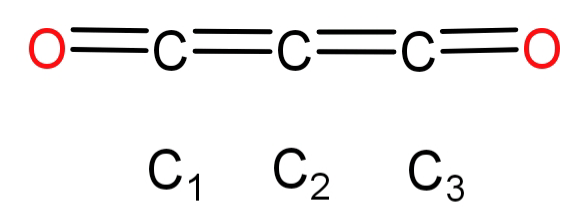
Hybridisation of carbon in
(A) sp
(B)
(C)
(D)
Answer
500.1k+ views
2 likes
Hint: First see the number of electrons in the outermost orbits of the element and then count the number of bonding regions and lone pairs formed by it in the particular compound. Accordingly see what the hybridisation will be.
Complete answer:
-Hybridisation is a basic concept of mixing of atomic orbitals to form new hybrid orbitals to form chemical bonds according to the valence bond theory.
-Before trying to deduce the hybridisation let us check a little about carbon atoms. It has an atomic number of 6 and its electronic configuration is:
-
Its structure is as follows:

In this we can see that each carbon forms double bonds with 2 other atoms (either other carbon or oxygen) and each carbon has 2 sigma (σ) and 2 pi (π) bonds. Also carbon has 4 electrons in its outermost shell and it cannot form more than 4 bonds, so no more bonding regions are possible. Let us just see the 3 carbon atoms and their bonding patterns:
For carbon 1 (
For carbon 2 (
For carbon 3 (
Hence we can say that the hybridisation of carbon in
The correct option will be: (A) sp
Note:
Remember that a double bond is counted as 1 electron region only and not 2 electron regions. Carbon superoxide is also considered as anhydride of malonic anhydride or second anhydride of malonic acid because it can be formed by heating a dry mixture of malonic acid (or its ester) and phosphorous pentoxide.
Complete answer:
-Hybridisation is a basic concept of mixing of atomic orbitals to form new hybrid orbitals to form chemical bonds according to the valence bond theory.
-Before trying to deduce the hybridisation let us check a little about carbon atoms. It has an atomic number of 6 and its electronic configuration is:
-
Its structure is as follows:

In this we can see that each carbon forms double bonds with 2 other atoms (either other carbon or oxygen) and each carbon has 2 sigma (σ) and 2 pi (π) bonds. Also carbon has 4 electrons in its outermost shell and it cannot form more than 4 bonds, so no more bonding regions are possible. Let us just see the 3 carbon atoms and their bonding patterns:
For carbon 1 (
For carbon 2 (
For carbon 3 (
Hence we can say that the hybridisation of carbon in
The correct option will be: (A) sp
Note:
Remember that a double bond is counted as 1 electron region only and not 2 electron regions. Carbon superoxide is also considered as anhydride of malonic anhydride or second anhydride of malonic acid because it can be formed by heating a dry mixture of malonic acid (or its ester) and phosphorous pentoxide.
Latest Vedantu courses for you
Grade 11 Science PCM | CBSE | SCHOOL | English
CBSE (2025-26)
School Full course for CBSE students
₹41,848 per year
Recently Updated Pages
Master Class 11 Economics: Engaging Questions & Answers for Success

Master Class 11 Business Studies: Engaging Questions & Answers for Success

Master Class 11 Accountancy: Engaging Questions & Answers for Success

Master Class 11 English: Engaging Questions & Answers for Success

Master Class 11 Computer Science: Engaging Questions & Answers for Success

Master Class 11 Maths: Engaging Questions & Answers for Success

Trending doubts
State and prove Bernoullis theorem class 11 physics CBSE

1 ton equals to A 100 kg B 1000 kg C 10 kg D 10000 class 11 physics CBSE

State the laws of reflection of light

One Metric ton is equal to kg A 10000 B 1000 C 100 class 11 physics CBSE

1 Quintal is equal to a 110 kg b 10 kg c 100kg d 1000 class 11 physics CBSE

Difference Between Prokaryotic Cells and Eukaryotic Cells




